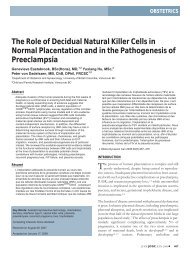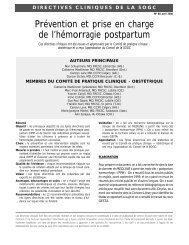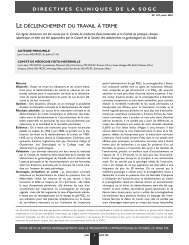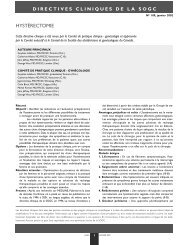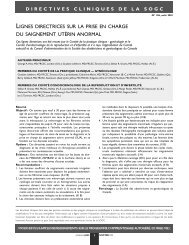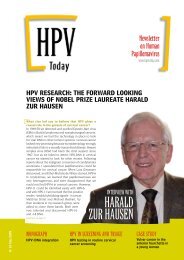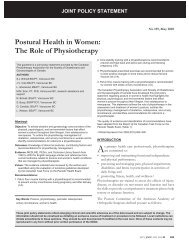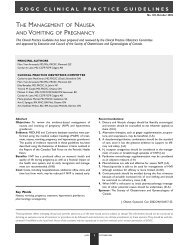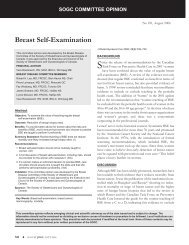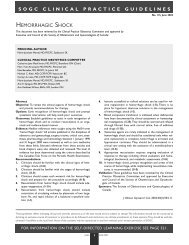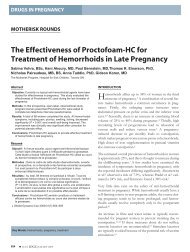Guidelines for operative vaginal birth - SOGC
Guidelines for operative vaginal birth - SOGC
Guidelines for operative vaginal birth - SOGC
Create successful ePaper yourself
Turn your PDF publications into a flip-book with our unique Google optimized e-Paper software.
<strong>for</strong>ceps were used <strong>for</strong> <strong>operative</strong> <strong>vaginal</strong> <strong>birth</strong>. 3,5<br />
Complication rates to the neonate were similar in both the<br />
<strong>for</strong>ceps- and vacuum-delivered groups. 3 Cephalohematomas and<br />
retinal hemorrhages are more common in vacuum deliveries. 3<br />
External ocular injuries and facial nerve palsies are more common<br />
with <strong>for</strong>ceps deliveries. 3 Serious complications are rare <strong>for</strong> both<br />
<strong>for</strong>ceps and vacuum deliveries but can lead to neonatal<br />
death. 1,7,21,22 A large retrospective study of primigravid women<br />
in Cali<strong>for</strong>nia 7 found infants were no more likely to die be<strong>for</strong>e discharge<br />
when delivered by vacuum or <strong>for</strong>ceps than by spontaneous<br />
<strong>vaginal</strong> <strong>birth</strong>. They were less likely to die if delivered <strong>vaginal</strong>ly<br />
than by Caesarean section. A neonate delivered by 2 <strong>operative</strong><br />
interventions (i.e., Caesarean section following a failed vacuum<br />
attempt or <strong>for</strong>ceps attempt, or vacuum and <strong>for</strong>ceps <strong>birth</strong>) is more<br />
likely to have a serious injury than one delivered by any one of<br />
these interventions alone. 7 Indeed, a positive correlation exists<br />
between the number of <strong>operative</strong> interventions in the second stage<br />
of labour and the likelihood of death or intracranial injury. 7 Other<br />
research has demonstrated similar results. 17,23,24<br />
Fetal injuries have been attributed to delay between a failed<br />
<strong>operative</strong> <strong>vaginal</strong> delivery and a Caesarean section. 22 Most <strong>operative</strong><br />
deliveries, including the application of a vacuum, should<br />
Table 4. Instrumental Birth<br />
Prerequisites Contraindications<br />
• vertex presentation<br />
• cervix is fully dilated and the membranes ruptured<br />
• head is fully engaged<br />
• exact position of the head can be determined so<br />
proper placement of the instrument can be<br />
achieved<br />
• pelvis is deemed adequate<br />
• in<strong>for</strong>med consent must be obtained<br />
• appropriate analgesia is in place<br />
• maternal bladder has been emptied<br />
• adequate facilities and backup personnel are<br />
available<br />
• operator must have the knowledge, experience,<br />
and skill necessary to use the instruments and<br />
manage complications that may arise<br />
• backup plan<br />
Table 5. Criteria <strong>for</strong> Types of Instrument-Assisted Births 18<br />
JOGC 750 AUGUST 2004<br />
be considered a trial. Unless the practitioner is certain that an<br />
<strong>operative</strong> <strong>vaginal</strong> delivery is going to be successful, the possibility<br />
of failure needs to be anticipated. In these circumstances,<br />
an alternative plan that will result in a safe and expeditious <strong>birth</strong><br />
must be in place and implemented promptly if the planned<br />
<strong>operative</strong> <strong>birth</strong> is unsuccessful.<br />
Clear documentation is important throughout labour and<br />
<strong>birth</strong>. Table 6 lists the elements to include when documenting<br />
instrumental <strong>birth</strong>.<br />
Table 6. Elements Required <strong>for</strong> Documentation of<br />
Instrumental Birth<br />
• indication <strong>for</strong> intervention<br />
• record of discussion with the woman of the risks, benefits, and<br />
options<br />
• position and station of the fetal head, as well as how it was<br />
assessed (i.e., <strong>vaginal</strong>ly and/or abdominally)<br />
• amount of moulding and caput present<br />
• assessment of maternal pelvis<br />
• assessment of fetal heart rate and contractions<br />
• number of attempts and ease of application of vacuum or<br />
<strong>for</strong>ceps<br />
• duration of traction and <strong>for</strong>ce used<br />
• description of maternal and neonatal injuries<br />
Relative<br />
• unfavourable attitude of fetal head<br />
• rotation >45° from occiput anterior or occiput<br />
posterior (vacuum)<br />
• mid-pelvic station<br />
• fetal prematurity. There is a small retrospective<br />
study reviewing the outcome of deliveries of<br />
infants 1500 g to 2500 g. No difference was<br />
found in Apgar scores, umbilical pH, or<br />
intraventricular hemorrhage when comparing<br />
vacuum extraction with controls who delivered<br />
spontaneously. 17<br />
Absolute<br />
• non-vertex or brow<br />
• unengaged head<br />
• incomplete cervix dilation<br />
• clinical evidence of cephalopelvic<br />
disproportion<br />
• fetal coagulopathy<br />
Outlet • fetal scalp visible without separating the labia<br />
• fetal skull has reached the pelvic floor<br />
• sagittal suture is in the anteroposterior diameter or right or left occiput anterior or posterior<br />
position (rotation does not exceed 45°)<br />
• fetal head is at or on the perineum<br />
Low • leading point of the skull is at station plus 2 cm or more and not on the pelvic floor<br />
Two subdivisions: (a) rotation of 45º or less, (b) rotation more than 45º<br />
Mid • fetal head is engaged<br />
• leading point of the skull is above station plus 2 cm



